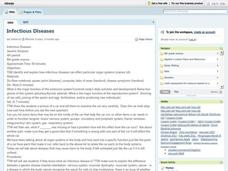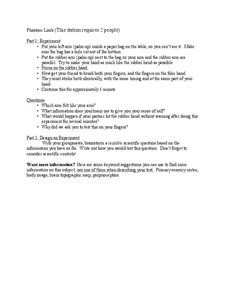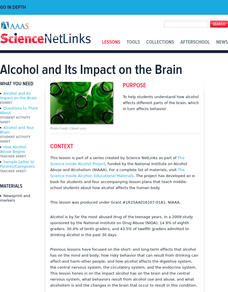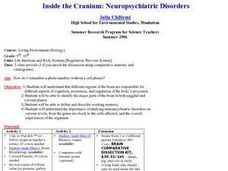Curated OER
How We Learn About the Brain: Teaching the Infant Brain
Students describe the development of an infant from conception to birth. In this biology lesson, students discover how a child's brain develop. They explain how children acquire motor and cognitive skills.
Scholastic
Prescription Pain Medication: What You Need to Know
The national epidemic of opioid addiction is making its way into high school populations. Educate the students in your class about the ways prescription opioids can both block pain and deliver large amounts of dopamine that make it very...
Curated OER
Coordination
Multiple choice, fill-in-the-blank, short answer, and matching questions are all here in a multi-page learning exercise or quiz. While the formatting leaves a little to be desired, it would take just a few minutes to change the handout...
Curated OER
Hand Sensitivity
Students experiment with the sense of touch. In this tactile instructional activity, students determine the most sensitive area of the hand. Students experiment by describing objects through touch only. Students compare the amount of...
Curated OER
Building a Clay Neuron
Students investigate and then build neurons in this lesson. They are examined as key parts of the brain and nervous system and seen as different from normal cells.
Curated OER
Getting Up the Nerve
Students examine the basics of the nervous system through an interactive program. They discover how the brain is linked to muscle movement. They can test cells through the interactive program to see how it reacts to different stimuli.
Curated OER
Brain Cells
In this brain cells worksheet, students learn about neurons. Students read about the different types of neurons and their life span. Students also study the neuron diagram and glial cells.
Curated OER
Infectious Diseases
Eighth graders identify and explain how infectious diseases effect organ systems. Using an analogy with automobiles and body systems, they discover how one part influences the operation of the whole. Students write paragraphs about...
University of Minnesota
Phantom Limb
A phantom of neuroscience may leave pupils perplexed as they engage in an experimental lesson that recreates a phantom limb scenario. After experiencing the phenomenon, they choose a scientific question to explore further.
Curated OER
Neuroscience for Kids Coloring Book
In this neuroscience activity, students color in 12 different parts of the nervous system, including the brain, spinal cord, and neurons.
IBM
The Human Body
Every moment, the systems in your body are working together to keep you breathing, standing, and thinking. Elementary schoolers explore the human body and its systems with an impressive, 15-page lesson plan that should leave your...
Nemours KidsHealth
Concussions: Grades 6-8
Teach middle schoolers to learn how to prevent concussions, recognize the symptoms of a concussion, and what they should do in case of a concussion. After reading articles that provide background information, groups create factsheets...
Nemours KidsHealth
Concussions: Grades 9-12
Spread the word about concussions! After reading articles about concussions and sports safety, small groups create paper slide videos to educate their peers about concussions, their symptoms, long-term consequences, and how to protect...
Curated OER
Constant Craving
Students experience the effect of sensory stimulation through a guided visualization. They explore possible genetic relationships between drug addiction and the nervous system by reading and discussing, "Genetic Studies Promise a Path to...
Curated OER
21st Century Medicine: Nerves of Steel
Students model a sarcomere's action, they gain a kinesthetic and visual understanding of muscle contraction. They use this exercise stimulates the production of myosin and actin. Students use two colors of clay, make a "sandwich" of...
Curated OER
Inside Information
Students explore two pathways for information through the nervous system. The pathways for involuntary action or reflex and voluntary responses are built and related to the element of choice.
Curated OER
Basic Animal Behavior in Domesticated Animals
Students investigate animal behavior, examining the nervous system and the physiology of the brain and the fight or flight response. They simulate animal behaviors and discuss the difference between an instinct and a behavior.
Curated OER
Making Connections: Exploring Our Brains through the Five Senses
Students record observations and create drawings and models of anatomy using their five senses. They describe the structures of a neuron and analyze each of their functions. They compare and contrast the typical structural features of a...
Curated OER
Growth and Development
Fourth graders explore an interactive site and discover new facts about the brain and its functions. They play a game demonstrating which areas of the brain control specific muscles.
Curated OER
The Laughing Brain 1: How We Laugh
Students to rate themselves on a scale from 1 to 10 (10 being the happiest) as to how happy they feel and write their rating on a sheet of paper. They explore gelotology (the science of laughter) and its benefits to our social, mental,...
Curated OER
Alcohol and Its Impact on the Brain
Students examine water as it changes states. In water and ice lesson students study the water cycle and what happens to it as it changes state.
Curated OER
Mapping the Homunculus
Students determine the relative number of nerve endings located in the skin. By calculating the reciprocal of these measurements, students have the appropriate data for predicting the relative size of the homunculus found on the cerebral...
Curated OER
It's All About Me!
Students study the five major body system in this unit. They examine how to keep themselves healthy.
Curated OER
Inside the Cranium: Neuropsychiatric Disorders
Young scholars analyze different regions of the brain which are responsible for different aspects of cognition, awareness and regulating the body's process.
Other popular searches
- Brain and Nervous System
- Brain Central Nervous System
- Brain Nervous System Quiz
- The Brain and Nervous System
- Brain Nervous System

























